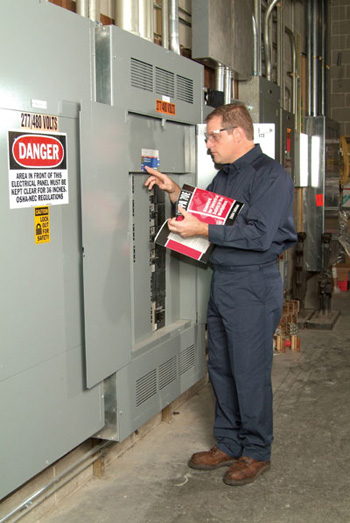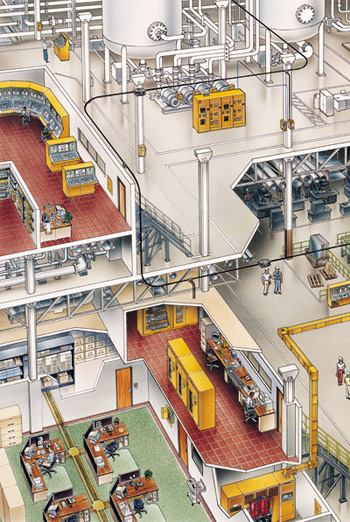Simply put, the lifeblood of industrial facilities is electrical power. Production processes, environmental controls and security, lighting and safety systems would grind to a halt without a clean, reliable and continuously available flow of electricity.
It is well understood by industrial facility owners and managers, and electrical inspectors that overcurrent protective devices like circuit breakers and fuses have a critical role in protecting the system and the connected load equipment from overload conditions, as well as from potentially damaging electrical faults. These devices also play a very important role in reducing the level of arc-flash hazard if an arcing fault occurs when someone is working on or near the equipment, or inspecting it. The incident energy (or thermal energy) that is released in an arcing fault is extremely dangerous to anyone in close proximity to it, such as an electrical worker who may be working on energized equipment or an inspector who’s opened a panelboard deadfront cover or a circuit breaker cubicle door on switchgear during an inspection.

Photo 1. This electrical worker is wearing NFPA 70E Hazard Risk Category 1 personal protective equipment (PPE), which is rated for 4 calories per square centimeter (4 cm2). Typically, a worker wearing Hazard Risk Category 1 PPE would also be wearing a hard hat for head protection. Photo copyright 2005 Oberon Company
But in many facilities, regular maintenance of the electrical system and connected load equipment has historically not been a high priority, a fact of which most electrical inspectors are painfully aware. One characteristic of improperly maintained electrical distribution equipment is that large switching devices (such as power circuit breakers or fused switch assemblies) can remain closed even under conditions where they should open. This means there is usually no immediate indication to industrial facility owners and managers of the failure, such as an interruption of the flow of power or other event that would bring attention to it. In fact, it could be months, or even years, before a problem is noted — typically, when an overcurrent protective device is called upon to do its job, but cannot.
Avoiding such a scenario requires proper maintenance completed at frequent intervals. As most electrical inspectors are aware, this is the most important step to maintain electrical distribution reliability and, more importantly, to increase safety for personnel, particularly workers who could be in the immediate vicinity of an arc-flash incident. Electrical inspectors can play a valuable role in apprising industrial facility owners and managers of the possible consequences for ignoring maintenance, including potential loss of revenue and business, as well as OSHA citations and fines, along with legal risks from accident litigation.
But they can also take a proactive stance, by providing counsel on multiple resources available for recommendations on maintenance of electrical equipment. That includes the original equipment manufacturers’ operation and maintenance manuals, advice from the service branches of those manufacturers and the 2006 edition of the National Fire Protection Association’s NFPA 70B consensus standard “Recommended Practice for Electrical Equipment Maintenance.”

Standards
The National Fire Protection Association’s NFPA 70E 2004 “Standard for Electrical Safety in the Workplace” requires industrial facilities to perform an arc-flash hazard analysis as one of the critical compliance steps outlined in electrical safety standards. These arc-flash hazard analyses are complex engineering studies that ultimately determine the amount of energy that would be released by each piece of electrical equipment that is studied if an arc flash event were to occur within that equipment. This information is needed in order to properly calculate the hazard-risk category of personal protective equipment (PPE) that personnel would be required to wear if they were required to work on energized equipment.
NFPA 70E has recognized for several years that elevated arc-flash hazard levels will occur if electrical protective devices are not maintained regularly. The 2008 edition of NFPA 70E (due this fall) addresses this in several places. When performing arc-flash hazard analyses, the software that performs the complex calculations assumes that the circuit breaker or fusible device will perform optimally to clear the fault. Any device that is in less than optimal condition due to poor maintenance will release a greater amount of hazardous energy than will be expected. Often the engineer performing the analysis has to make a judgment based on the maintenance condition of the device under study. In many cases, the engineer will request current injection testing be done to document its operation.
The 2004 edition of NFPA 70E refers to NFPA 70B in a fine print note for maintenance requirements, in chapter 2, article 200.1 NFPA 70B, which has been available since the early 1970s, contains recommendations and details for electrical equipment maintenance intervals based on equipment type and environmental and duty conditions. Annex H of NFPA 70B provides recommended maintenance intervals for most types of electrical distribution equipment found in industrial facilities. Intervals depend on the type of equipment; for example, it states that low-voltage switchgear should be inspected every three to six months, and undergo an overhaul and maintenance every three to six years.
Getting started
Because NFPA 70B is a recommended practice, there is no mechanism for enforcement by OSHA; consequently, there have been concerns for years that NFPA 70B was not being observed adequately. But the fact remains that proper maintenance of electrical equipment is well recognized as a factor for any company that understands the risk of electrical accidents and wishes to avoid those risks wherever possible, in order to protect workers and equipment.
But knowing where to start can typically be the most challenging part of electrical distribution system maintenance, which can provide another opportunity for electrical inspectors to provide counsel to industrial facility owners and managers. The best rule of thumb is to recommend making contact with the services branch of an established electrical equipment manufacturer, which can provide detailed arc-flash analyses, recommendations on equipment replacements or upgrades and even help develop and complete all relevant maintenance work and documentation. Only then can owners and managers feel confident that their facility is compliant with NFPA 70E.
1 Chapter 2 of NFPA 70E 2004 is titled “Safety-Related Maintenance Requirements.” It states “Chapter 2 covers practical safety-related maintenance requirements for electrical equipment and installations in workplaces as included in 90.1. These requirements identify only that maintenance (is) directly associated with employee safety. Chapter 2 does not prescribe specific maintenance methods or testing procedures. It is left up to the employer to choose these from the methods available.”










Find Us on Socials